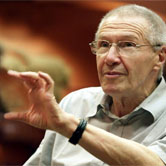Over the past century, Hungary has produced a disproportionate share of the world’s great music. Saturday night, Gyorgy Kurtag, the reigning scion of the dynasty of Kodaly, Bartok, and Ligeti, was represented on the closing concert of the “Soundings” series at the Nasher Sculpture Center by a relentlessly enthralling performance of his Kafka Fragments of 1987.
Is “monumental” really the right word for this cycle for soprano and violin? On several levels, the work feels monumental, but on several levels, “intimate” and even “miniature” are equally accurate. The literary text, drawn from various jottings, diaries, and letters of the German-Czech genius Franz Kafka, is inherently expansive. Even the minute observations of Kafka exude an aura of significance. Observe, for instance, the bare, cold poetry of the note, “Slept, woke up, slept, woke up, miserable life,” or the inescapable wisdom of the aphorism, “From a certain point on, there is no turning back again. This is the point to be reached.”
Kurtag, now 85, selected a total of forty-two such fragments and set each as an independent movement, constantly tempting the listener to search for a trajectory, and constantly evading a clearly defined direction. The listener or performer who looks for an easy plotline or readily discernable thread will be disappointed. The key to this work lies in allowing it to develop unconsciously within the listener.
In keeping with the tradition of Bartok and Ligeti, Kurtag is, here, often blatantly obvious and pictorial: the phrase “The good walk in step” was set to an obvious marching rhythm, for example, while the word zögern (“hesitation”) was stretched.
But, as in Bartok and Ligeti, there’s a sense of integrity—underscored by the constant, skillful use of dissonance—that transcends any possibility of triteness or commonplace. It takes a supreme understanding of timbre, harmony, and the technical possibilities of the violin to create the aural image of a tightrope, as Kurtag does in the twentieth song, and it also takes a remarkable sense of judgment and balance to pull it off.
A work this emotionally intense and technically difficult (some passages border on the impossible) demands performers with a supreme technique; soprano Susan Narucki and violinist Violaine Melancon were more than equal to the task. Narucki brought the dramatic range of an opera role, with magnificent variety of tone, as well as the willingness to stretch from a low F to a high C-sharp. Melancon successfully explored the catalog of technical demands and tunings that necessitated, as instructed by the composer, two violins on stage. Together, they produced the unfailingly engaging and continually building effect Kurtag clearly aimed for.
The concert marked the close of the first season of the Soundings. The vision of artistic director Seth Knapp, along with his ability to conceive and produce programs of this sort, have already made, in less than a year, a significant mark on the musical culture of Dallas.
Photo: Gyorgy Kurtag (Courtesy of Editio Musica Budapest)





